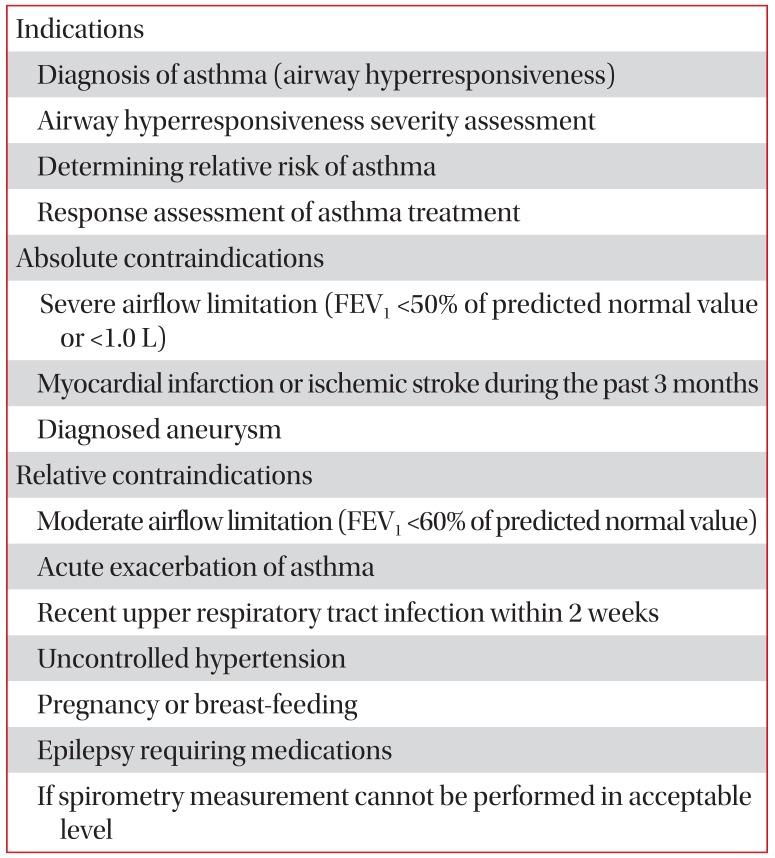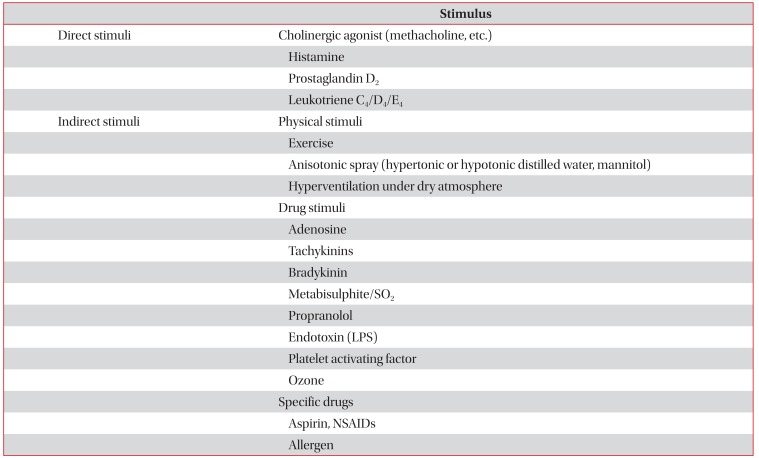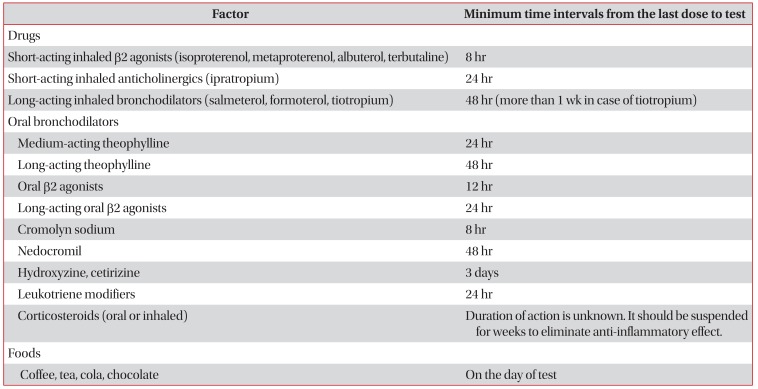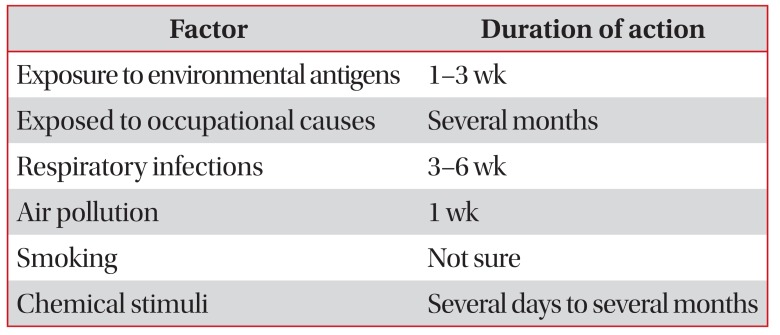1. Sterk PJ, Fabbri LM, Quanjer PH, Cockcroft DW, O'Byrne PM, Anderson SD, et al. Airway responsiveness: standardized challenge testing with pharmacological, physical and sensitizing stimuli in adults. Report Working Party Standardization of Lung Function Tests, European Community for Steel and Coal. Official Statement of the European Respiratory Society. Eur Respir J Suppl. 1993; 16:53–83. PMID:
8499055.
2. Crapo RO, Casaburi R, Coates AL, Enright PL, Hankinson JL, Irvin CG, et al. Guidelines for methacholine and exercise challenge testing-1999. This official statement of the American Thoracic Society was adopted by the ATS Board of Directors, July 1999. Am J Respir Crit Care Med. 2000; 161:309–329. PMID:
10619836.
3. Perpina Tordera M, Garcia Rio F, Alvarez Gutierrez FJ, Cisneros Serrano C, Compte Torrero L, Entrenas Costa LM, et al. Guidelines for the study of nonspecific bronchial hyperresponsiveness in asthma. Spanish Society of Pulmonology and Thoracic Surgery (SEPAR). Arch Bronconeumol. 2013; 49:432–446. PMID:
23896599.
4. Bochner BS, Undem BJ, Lichtenstein LM. Immunological aspects of allergic asthma. Annu Rev Immunol. 1994; 12:295–335. PMID:
8011284.

5. Woolcock AJ, Salome CM, Yan K. The shape of the dose-response curve to histamine in asthmatic and normal subjects. Am Rev Respir Dis. 1984; 130:71–75. PMID:
6234831.
6. Grootendorst DC, Rabe KF. Mechanisms of bronchial hyperreactivity in asthma and chronic obstructive pulmonary disease. Proc Am Thorac Soc. 2004; 1:77–87. PMID:
16113417.

7. Joos GF. Bronchial hyperresponsiveness: too complex to be useful? Curr Opin Pharmacol. 2003; 3:233–238. PMID:
12810185.

8. Busse WW. The relationship of airway hyperresponsiveness and airway inflammation: airway hyperresponsiveness in asthma: its measurement and clinical significance. Chest. 2010; 138(2 Suppl):4S–10S. PMID:
20668012.
9. Joos GF, O'Connor B, Anderson SD, Chung F, Cockcroft DW, Dahlen B, et al. Indirect airway challenges. Eur Respir J. 2003; 21:1050–1068. PMID:
12797503.

10. Cockcroft D, Davis B. Direct and indirect challenges in the clinical assessment of asthma. Ann Allergy Asthma Immunol. 2009; 103:363–369. PMID:
19927533.

11. O'Byrne PM, Inman MD. Airway hyperresponsiveness. Chest. 2003; 123(3 Suppl):411S–416S. PMID:
12629006.
12. Hargreave FE, Ryan G, Thomson NC, O'Byrne PM, Latimer K, Juniper EF, et al. Bronchial responsiveness to histamine or methacholine in asthma: measurement and clinical significance. J Allergy Clin Immunol. 1981; 68:347–355. PMID:
7028842.

13. Gilbert R, Auchincloss JH Jr. Post-test probability of asthma following methacholine challenge. Chest. 1990; 97:562–565. PMID:
2407450.

14. Cockcroft DW, Murdock KY, Berscheid BA, Gore BP. Sensitivity and specificity of histamine PC
20 determination in a random selection of young college students. J Allergy Clin Immunol. 1992; 89(1 Pt 1):23–30. PMID:
1730837.
15. Cockcroft DW. Methacholine challenge: PD
20 versus PC
20. Ann Am Thorac Soc. 2015; 12:291–292. PMID:
25786145.
16. Sverrild A, Porsbjerg C, Backer V. The use of inhaled mannitol in the diagnosis and management of asthma. Expert Opin Pharmacother. 2012; 13:115–123. PMID:
22118547.

17. Anderson SD. Indirect challenge tests: airway hyperresponsiveness in asthma: its measurement and clinical significance. Chest. 2010; 138(2 Suppl):25S–30S. PMID:
20668015.
18. Franklin PJ, Stick SM, Le Souef PN, Ayres JG, Turner SW. Measuring exhaled nitric oxide levels in adults: the importance of atopy and airway responsiveness. Chest. 2004; 126:1540–1545. PMID:
15539724.
19. Koskela HO, Hyvarinen L, Brannan JD, Chan HK, Anderson SD. Responsiveness to three bronchial provocation tests in patients with asthma. Chest. 2003; 124:2171–2177. PMID:
14665497.

Brannan JD., Anderson SD., Perry CP., Freed-Martens R., Lassig AR., Charlton B, et al. The safety and efficacy of inhaled dry powder mannitol as a bronchial provocation test for airway hyperresponsiveness: a phase 3 comparison study with hypertonic (4.5%) saline. Respir Res. 2005. 6:144. PMID:
16336673.

21. Leuppi JD, Brannan JD, Anderson SD. Bronchial provocation tests: the rationale for using inhaled mannitol as a test for airway hyperresponsiveness. Swiss Med Wkly. 2002; 132:151–158. PMID:
12070787.
22. Koskela HO, Hyvarinen L, Brannan JD, Chan HK, Anderson SD. Coughing during mannitol challenge is associated with asthma. Chest. 2004; 125:1985–1992. PMID:
15189912.

23. Deal EC Jr, McFadden ER Jr, Ingram RH Jr, Strauss RH, Jaeger JJ. Role of respiratory heat exchange in production of exercise-induced asthma. J Appl Physiol Respir Environ Exerc Physiol. 1979; 46:467–475. PMID:
438014.

24. Finnerty JP, Holgate ST. Evidence for the roles of histamine and prostaglandins as mediators in exercise-induced asthma: the inhibitory effect of terfenadine and flurbiprofen alone and in combination. Eur Respir J. 1990; 3:540–547. PMID:
1695877.
25. Randolph C. Exercise-induced asthma: update on pathophysiology, clinical diagnosis, and treatment. Curr Probl Pediatr. 1997; 27:53–77. PMID:
9059761.

26. Nish WA, Schwietz LA. Underdiagnosis of asthma in young adults presenting for USAF basic training. Ann Allergy. 1992; 69:239–242. PMID:
1524281.
27. Sinclair DG, Sims MM, Hoad NA, Winfield CR. Exercise-induced airway narrowing in army recruits with a history of childhood asthma. Eur Respir J. 1995; 8:1314–1317. PMID:
7489796.

28. Haby MM, Anderson SD, Peat JK, Mellis CM, Toelle BG, Woolcock AJ. An exercise challenge protocol for epidemiological studies of asthma in children: comparison with histamine challenge. Eur Respir J. 1994; 7:43–49. PMID:
8143831.








 PDF
PDF ePub
ePub Citation
Citation Print
Print



 XML Download
XML Download